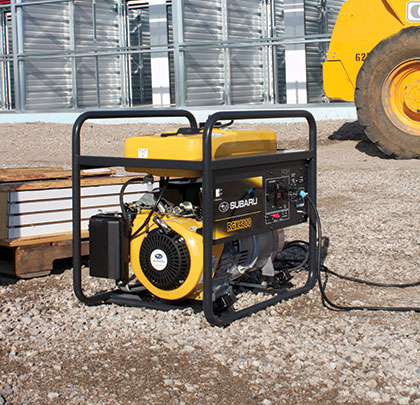Manufacturers Staying Ahead of Changes in Equipment Lifecycles.
Though this isn’t the first time the industry has experienced tough times, the recent “Great Recession” has reshaped the attitudes of manufacturers, rental centers, and end-user contractors. Gone are the days of upgrading equipment fleets every 2 years. Today’s fleets have pushed lifecycles out to 4 or 5 years. In fact, the October 2012 Rouse Rental Report states that the industry average for rental equipment—compaction equipment for example—is currently at 47.5 months.
With plenty of pressure coming from dealers, rental centers, and contractors, manufacturers are taking significant steps to accommodate the changing lifecycle trends and meet the market demands. With a little research and understanding, customers can ensure they choose the best equipment for their investment.
KEEPING THE USED
Over the last 3 years, sales of new equipment have slowed and sales of parts have climbed to new heights as consumers have been forced to keep their equipment longer. Naturally, this places heavy pressure on manufacturers to continue producing high-quality, longer-lasting equipment that’s easy to maintain, all while keeping initial costs low.
However, as the trend has set in, manufacturers have been forced to decide between higher quality or lower prices. Manufacturers either have to pull back on customer service and skimp on production to provide a less expensive product or use time provided by the slowdown to enhance designs for better, more efficient products. A select few use the downturn to boost their innovation and creativity. Such innovative companies are setting an example for the rest of the industry to help ensure standards aren’t lowered across the board.
ENGINE EXCELLENCE
A machine is only as good as its engine. From an OEM’s perspective, a high-quality engine is imperative to building a longer lasting product. At the same time, it can mean a higher investment and higher cost for the customer. The real issue becomes the threshold of what the consumer sees as valuable and what he or she is willing to pay for a higher quality piece of equipment.
There has always been a tendency to gravitate toward cheaper engines with simple, standardized designs. But the value of a quality engine, backed by solid service and support, can’t be overstated. It goes back to looking at a piece of equipment not just as a machine, but rather as an investment.
To keep in step with equipment that’s expected to last longer and perform better, the engine must be held to higher standards. When examining a product, specifically an engine, consumers should consider its technology and design. Was it built using older technology, or has the engine been reengineered to feature more modern designs that may improve performance and extend life?
For example, within the past few years, chain driven overhead cam (OHC) technology was introduced to the market. Engines that incorporate this technology have fewer moving parts to reduce mechanical noise and enable quieter operation. Further, they put out fewer emissions. This design has the potential to revolutionize the small, air-cooled engine market.
Another example of advanced technology came with the introduction of Electronic Fuel Injection (EFI) engines to the small engine market. These engines are known to reduce fuel consumption and emissions, while providing fast, easy starts in a wide range of temperatures.
Another quality criteria to consider is how the engine is produced. To achieve the highest product consistency, look at how the product was manufactured. Equipment that is manufactured in high-tech facilities with full automation is guaranteed to be assembled accurately.
BEYOND THE MACHINE
Manufacturers aren’t the only ones feeling the heat during the extension of lifecycles. For instance, independent rental companies are now holding onto their equipment for up to 5 years, or up to 3 years for larger rental houses.
Recently, some manufacturers have stepped up to offer a 5-year warranty on their engines. While warranties are certainly something we all hope we never have to use, a couple of primary benefits of these extended warranties should be considered.
First, the only reason a company will typically offer an extended warranty is because it has high confidence in its product and very few warranty claims overall. If dealers, rental centers, or contractors find a product that has a longer warranty, they can be assured that manufacturer has confidence that the customer will never even need to use the warranty.
Second, the longer warranty will now provide protection through the lifecycle of that product for most rental centers and first-owner contractors. Knowing that the engine is covered if anything should happen creates the confidence needed to hold on to the equipment and maximize its use in the challenging economic environment.
Finally, if the rental center or primary contractor decides to sell that product, some warranty policies may offer a transfer of warranty, which will then offer an added advantage or incentive for the second owner.
A GLANCE INTO THE FUTURE
Few believe we’ve weathered the storm. The way of doing business has changed for years to come, and these equipment trends will likely be accepted as the norm. But hard times equate to better business, and one thing is for certain: when the economy gains a stronger foothold and things get closer to what we once considered normal, the companies that make it through—whether they’re rental centers, contractors, or manufacturers—will be likely to have gained a whole new level of strength. ■
About The Author:
Brad Murphy is the vice president and COO at Subaru Industrial Power Products. Murphy is in charge of customer service, operations, sales, and IT, and has been with the company for approximately 16 years. For more information on Subaru Industrial Power products, visit www.subarupower.com.
_________________________________________________________________________
Modern Contractor Solutions, March 2013
Did you enjoy this article?
Subscribe to the FREE Digital Edition of Modern Contractor Solutions magazine.

Ahead of the Curve


